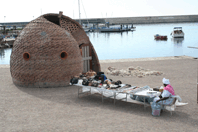THE CITY- THE PORT-THE SEA The evolutive features of a complex relation
DOI:
https://doi.org/10.6092/2281-4574/2211Keywords:
città, porto, mareAbstract
The balanced relation between the city and the sea was at the centre of the Greek philosophy. During the flourishing of the Hellenic civilization, Plato began wondering about the appropriate characteristics of a site for an urban settlement near the sea. An ideal-type of urban settlement model resulted, based on accessibility, safety, hygienism, productivity, proximity to energy sources, prosperity.
Renaissance artists appealed to the ancient knowledge in order to renew the treatises about architecture and town planning, in the perspective of building new models aiming at making perfect the structure and the soul of the city through a strictly geometric form.
The harbour rose with open arms, towards the sea; a hug aiming at showing the pleasure of meeting, guaranteeing shelter, protection, safety and friendly welcome.
On the contrary, the harbour turns its back to the city and sometimes it moves the city away, in order to keep a certain distance.
Physical and institutional barriers intervene between the city and the sea, claiming autonomous political-administrative and planning roles, often hindering, instead of fostering, natural osmotic processes, debasing functions, roles and social, economic, political and cultural interests of reciprocal belonging.
Almost everywhere the legislative evolution has followed, and not preceded, the territorial devastation of settlements along the coasts – especially the devastation spontaneously risen – and only later has tried to hold in check a phenomenon sadly fallen in the ways of doing and the emptiness of thinking, letting the “habit of doing” prevail the conservative legislation based on placing pickets to the “not to do” approach; that situation in the light of an economic power become the director of political power, conditioned at opening eyes on doing for half-closing eyes on business.
The new city-sea relation has to be studied as a valorisation, not as mere protective measures prescribed by ordinary landscape/town planning tools, or as design interventions for the aesthetic renewal of waterfront building facade. We need to go further, allowing the city to demolish definitely the port barriers which still deprive it of the fruition of its sea, acting consistently with the intervention designed and implemented by Hippodamus of Miletus in Athens during the Age of Pericles, so that the city could join its port (Piraeus), thought with some mediation: a protective wall which would sanction a right of reciprocal belonging, physically and institutionally, between the city and the sea.
Downloads

Downloads
Published
Issue
Section
License
Gli autori che pubblicano su questa rivista accettano le seguenti condizioni:- Gli autori mantengono i diritti sulla loro opera e cedono alla rivista il diritto di prima pubblicazione dell'opera, contemporaneamente licenziata sotto una Licenza Creative Commons - Attribuzione che permette ad altri di condividere l'opera indicando la paternità intellettuale e la prima pubblicazione su questa rivista.
- Gli autori possono aderire ad altri accordi di licenza non esclusiva per la distribuzione della versione dell'opera pubblicata (es. depositarla in un archivio istituzionale o pubblicarla in una monografia), a patto di indicare che la prima pubblicazione è avvenuta su questa rivista.
- Gli autori possono diffondere la loro opera online (es. in repository istituzionali o nel loro sito web) prima e durante il processo di submission, poiché può portare a scambi produttivi e aumentare le citazioni dell'opera pubblicata (Vedi The Effect of Open Access).

